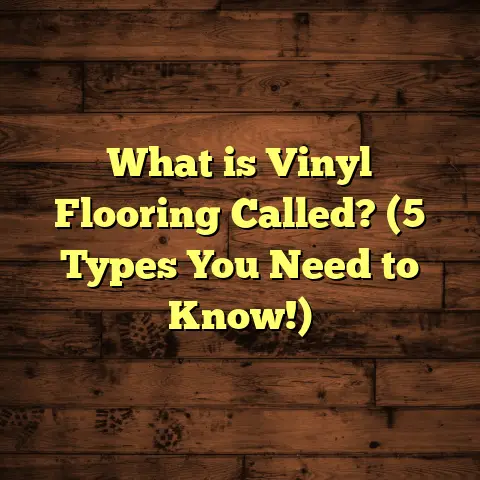What is Ground in Dirt on Floors? (5 Ways to Tackle Grime)
I once faced a stubborn problem that many homeowners dread: floors that just wouldn’t get clean no matter how much I scrubbed. The dirt seemed to sink in, becoming part of the floor itself. It felt like a mystery—why was this grime so persistent? This is what led me to explore deeply the subject of ground-in dirt on floors and how best to tackle it. If you’ve ever wondered why your floors look dingy even after cleaning, or how to get that ingrained dirt out without damaging your flooring, I’ve got some insights and experiences to share.
What Is Ground-In Dirt on Floors?
Ground-in dirt isn’t just surface dust or loose debris. It’s the kind of grime that becomes embedded into the pores, cracks, and textures of your flooring material. Think about the tiny particles that get pushed deeper every time someone walks across, the oils from shoes, spilled liquids that dry, and microscopic grit that settles in. Over time, this dirt hardens and becomes more like a stain or residue rather than something you can easily sweep or mop away.
This type of dirt is common across all flooring types—whether it’s hardwood, tile, laminate, or even carpet. The difference lies in how deeply the dirt can embed itself and how challenging it is to remove without harming the floor’s surface. For instance, hardwood floors have natural grain and small knots where dirt can hide. Tile floors have grout lines that act like magnets for grime. Laminate floors might have microscopic scratches that trap dust and dirt.
From my experience, ground-in dirt is often underestimated because it’s not always visible immediately. You might think your floor looks fine, but when you run your hand across it or see it in certain lighting, you’ll notice a dullness or rough texture that wasn’t there before. That’s the dirt beneath the surface making your floor look worn out.
Why Does Ground-In Dirt Matter?
You might ask yourself: why not just mop regularly? Well, regular cleaning only removes surface dirt. Ground-in dirt affects the longevity and look of your flooring. It can cause discoloration, wear down protective coatings, and even lead to permanent damage if left untreated. For hardwood floors, this could mean scratches or dull areas where the finish has worn off.
In one of my projects involving an older house with original oak flooring, I noticed some spots looked darker and felt rougher. After testing different cleaning methods, I realized these were areas with heavy ground-in dirt combined with old wax buildup. It took a specialized approach to restore those spots without stripping the entire floor.
You might not realize it, but ground-in dirt can also impact indoor air quality. Dust and allergens settle in these deposits and get disturbed every time you walk through a room. This aggravates allergies and respiratory issues for many people. So tackling this grime doesn’t just help your floor—it helps your health too.
How Dirt Gets Ground Into Floors
Understanding how ground-in dirt forms can help you figure out the best ways to get rid of it. Dirt starts as loose particles—soil from outside, dust from inside, pet dander, oils from feet—all of which settle on your floor daily. When these particles get walked on repeatedly, they’re forced deeper into whatever material your floor is made of.
Hardwood floors have tiny pores and natural grain patterns where grit slips in. Tile floors have grout lines that act like little crevices trapping dust and stains. Carpet fibers trap dirt inside their weave. Even laminate floors with a seemingly smooth surface have microscopic cracks and scratches that harbor dust.
Humidity and moisture also play a role. Moisture softens dirt particles and allows them to bond with the floor surface more firmly. In humid climates or homes with pets and kids, this grime builds up faster.
Common Sources of Ground-In Dirt
- Outdoor debris: Mud, sand, leaves tracked inside by shoes.
- Dust and pollen: Airborne particles that settle over time.
- Oils and sweat: From feet or pets walking around.
- Food spills: Dried spills become tough stains.
- Pet hair and dander: Mixes with dust to form grime.
- Cleaning residues: Soap scum or wax buildup from improper cleaning.
Different Ways I’ve Tackled Ground-In Dirt
Over the years, I’ve tried various methods to deal with stubborn grime. Each had its pros and cons depending on the floor type and level of dirt. Here are five effective approaches I’ve found useful:
1. Deep Steam Cleaning
Steam cleaning uses hot vapor to loosen and lift embedded dirt. For tile and grout floors especially, steam cleaners work wonders. When I first used a commercial steam cleaner on a ceramic tile kitchen floor, the grout lines went from dull gray to bright white after just one session.
The heat breaks down grease and grime without harsh chemicals, which is a big plus for homes with kids or pets. Steam gets into tiny crevices where mops can’t reach.
But steam cleaning isn’t a one-size-fits-all solution. For hardwood floors, too much moisture can be harmful, causing warping or swelling. So I recommend using low-moisture steam cleaners designed specifically for wood or test a small area first.
For carpets, steam cleaning (or hot water extraction) is great for removing ground-in dirt but requires professional-grade machines for best results.
My experience: I once used a handheld steam cleaner on a grout-heavy bathroom floor that hadn’t been cleaned properly in years. The transformation was impressive—the grout looked almost new again without any scrubbing needed.
2. Scrubbing with Specialized Floor Cleaners
Sometimes a simple mop won’t cut it. I’ve often used floor cleaners formulated for tough stains—like those containing enzymes or micro-abrasives—to break down oils and dirt embedded in floors. For example, on older laminate floors with scuff marks and dirt buildup, scrubbing gently with a microfiber mop soaked in a pH-neutral cleaner worked well.
It’s important to choose cleaners that won’t strip protective finishes or cause discoloration. I always check product labels carefully and do spot tests to avoid damage.
Some products are designed specifically for certain flooring types—wood floor cleaners with oils to nourish the wood while cleaning; tile cleaners with anti-mildew agents; vinyl cleaners that don’t leave behind residue.
Pro tip: Avoid using bleach or ammonia-based cleaners on hardwood or laminate—they can cause discoloration over time.
My story: I cleaned a client’s vinyl kitchen floor covered in sticky residues from cooking spills using an enzyme-based cleaner recommended by the manufacturer. After scrubbing lightly with a soft brush, the floor looked fresh again without any damage.
3. Using Floor Polishers or Buffers
For hardwood floors with ground-in dirt trapped in scratches or dull areas, using a buffer machine combined with a polishing compound can restore shine while cleaning deep grime. This method requires some skill to avoid over-sanding or uneven finishes.
One time I rented a buffer for a client’s maple floor and combined it with a mild abrasive polish. The results were remarkable—the floor looked almost new after removing years of embedded dirt and minor scratches.
Buffers use rotating pads to gently abrade the surface just enough to remove surface scratches and embedded grime without removing too much wood.
Things to watch out for:
- Don’t use on delicate finishes.
- Use correct pads for your floor type.
- Hire professionals if unsure—you don’t want uneven spots or damage.
4. DIY Solutions: Vinegar, Baking Soda, and More
I’ve experimented with home remedies like vinegar solutions and baking soda pastes for lighter grime. Vinegar is acidic and can help dissolve mineral deposits or soap scum on tile floors but it’s a no-go for hardwood as it can dull the finish.
Baking soda mixed with water forms a gentle abrasive paste that lifts dirt without scratching. On vinyl floors, applying this paste with a soft brush removed stubborn stains effectively.
A mix of vinegar and water (usually 1:1) makes an effective all-purpose cleaner for tiles but be sure to rinse well afterward to avoid residue buildup.
Why these work:
- Vinegar breaks down mineral deposits.
- Baking soda lifts stains by mild abrasion.
- Both are non-toxic options safe for many homes.
My tale: When my kids painted their playroom walls (and accidentally spilled paint on laminate floors), I used baking soda paste to lift the dried paint spots without scratching the surface.
5. Professional Floor Restoration
Sometimes ground-in dirt is just too stubborn for home methods. When I encounter such cases—especially on expensive hardwood or stone floors—I recommend professional restoration services. These experts use specialized machines and chemicals that clean deeply without damaging the surface.
In one recent project involving an old farmhouse’s pine floors, professional cleaning followed by refinishing brought back their charm after decades of neglect.
Professional restoration usually includes:
- Deep cleaning
- Sanding away damaged layers
- Reapplying protective finishes
Costs vary widely depending on floor size and damage level but expect anywhere from $3 to $8 per square foot as a rough ballpark in many regions.
Comparing These Approaches: What Worked Best?
Each method has its place depending on the type of floor and how bad the grime is. Here’s what I learned from comparing them:
| Method | Best For | Pros | Cons |
|---|---|---|---|
| Steam Cleaning | Tile, grout | Deep cleaning without chemicals | Can damage wood if not careful |
| Specialized Cleaners | Laminate, vinyl, wood | Effective on oils and stains | Some chemicals can harm sensitive floors |
| Floor Polishers/Buffers | Hardwood | Restores shine and cleans deeply | Requires skill; risk of damage |
| DIY Solutions | Light grime on various floors | Cost-effective; gentle | Limited effectiveness on heavy dirt |
| Professional Restoration | All types, heavy grime | Thorough cleaning; restores floors fully | Expensive; needs scheduling |
Personally, I often combine methods depending on the situation. For example, I start with specialized cleaners for routine maintenance but call in professionals when deep restoration is needed.
Case Studies: Real-Life Examples of Tackling Ground-In Dirt
Case Study 1: Kitchen Tile Grout Rescue
A client’s kitchen had grout lines blackened by years of neglect. The grout looked permanently stained despite regular mopping. After assessing options, I used a commercial steam cleaner combined with an oxygen bleach grout cleaner over several sessions.
Result? The grout was restored close to its original white shade—something no mop-and-bucket routine had achieved in years.
Case Study 2: Hardwood Floor Revival
An old Victorian home had hardwood floors dulled by embedded pet dander and ground-in dirt mixed with old wax layers. Initial cleaning attempts failed to improve appearance significantly.
I rented a buffer machine, used a gentle polishing compound formulated for hardwoods, then applied a fresh coat of polyurethane finish afterward.
The floor came alive—showing rich color and satin shine after years of looking dull.
Case Study 3: Vinyl Floor Stain Removal
In a busy daycare center, vinyl floors had sticky residues from snacks smeared into scratches over months. Using baking soda paste applied with soft brushes removed most stains without harsh chemicals that might bother kids’ sensitive skin.
Routine maintenance afterward kept the floors looking fresh longer between deep cleans.
Detailed Data Points & Industry Insights
- According to the International Cleaning Institute (ICI), floors cleaned only superficially accumulate 50% more embedded dirt after six months compared to those receiving periodic deep cleans.
- The average home accumulates between 40-100 pounds of dirt annually simply by foot traffic.
- A survey by Floor Covering Weekly found that households investing in professional floor restoration saw an average increase of 20% in flooring lifespan.
- Grout lines absorb up to 30% more dirt than surrounding tiles due to their porous nature.
- Hardwood flooring finishes degrade up to 25% faster in high foot traffic areas if ground-in dirt isn’t removed regularly.
These numbers show just how much difference proper cleaning makes—not just visually but financially in maintenance costs over time.
How I Use Tools Like FloorTally for Flooring Projects
When working on floor installation or refurbishing projects, estimating costs accurately is always challenging. I rely on tools like FloorTally to get clear cost estimates based on local prices for materials and labor. It helps me choose flooring options that fit my budget without surprises.
FloorTally also factors in waste percentages—something many overlook—which helps me order just enough material to cover ground-in dirt removal prep without overspending. This tool saves me time by consolidating all calculations in one place instead of juggling multiple quotes.
Because I deal with various types of flooring—hardwood, laminate, tile—I appreciate how FloorTally lets me customize my choices based on material type, finish level, labor rates in different regions, even texture preferences. It ensures I’m not guessing but working with realistic numbers every time.
Maintenance Tips To Prevent Ground-In Dirt Build-Up
Once you’ve tackled stubborn grime successfully, keeping it at bay is the next challenge. Here are some tips I’ve found useful:
- Use doormats at all entrances: They reduce tracking in soil by up to 80%.
- Establish ‘no shoes indoors’ rules: Simple but effective.
- Regular sweeping/vacuuming: Prevents loose dirt from turning into ground-in grime.
- Use appropriate cleaners frequently: Avoid harsh chemicals that damage finishes.
- Protect high traffic zones with rugs: Especially near entryways or kitchens.
- Schedule periodic deep cleans: Every 6-12 months depending on traffic.
- Maintain humidity levels: Too much moisture promotes grime bonding; too little dries out wood floors.
Common Mistakes When Trying To Remove Ground-In Dirt
Here are some pitfalls I’ve seen both DIYers and pros fall into:
- Using excessive water on hardwood leading to warping.
- Applying harsh chemicals without testing causing discoloration.
- Over-scrubbing creating scratches deeper than grime.
- Ignoring grout lines or edges where dirt hides most.
- Skipping protective finishes after deep cleaning leaving wood vulnerable.
- Underestimating cost/time leading to rushed jobs with poor results.
Avoiding these mistakes makes tackling ground-in dirt less frustrating and more effective.
Final Thoughts
Ground-in dirt is more than just an eyesore; it affects the health and lifespan of your floors. Through trial and error over years, I’ve found that a mix of cleaning techniques tailored to your specific floor type works best. Whether it’s steam cleaning tile grout or using polishers on hardwood, knowing what fits your needs makes all the difference.
Have you ever struggled with grimy floors that just won’t come clean? What methods have you tried? I’d love to hear your stories or help troubleshoot tough spots.
If you’re planning any flooring work soon—or just want to keep your floors looking fresh—consider these approaches carefully. Trust me, tackling ground-in dirt effectively will save you time, money, and headaches down the road!





